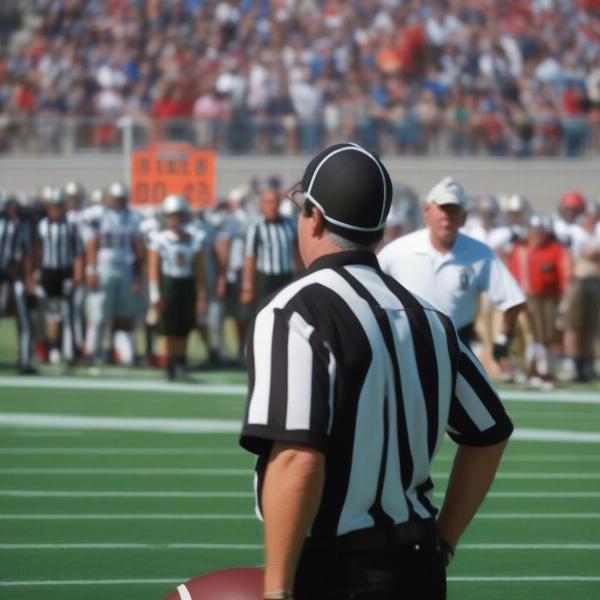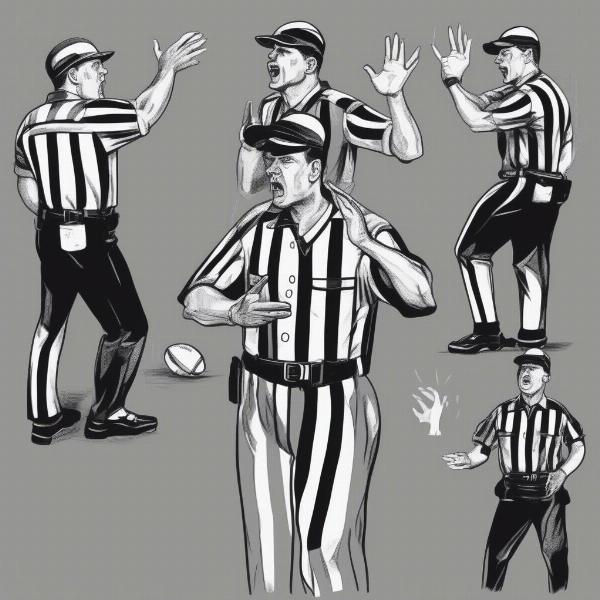Delay of game is a crucial infraction in American football, impacting the flow and outcome of games. At SupremeDuelist.blog, we delve deep into the intricacies of the sport, providing you with comprehensive guides and analysis. This article will explain the delay of game penalty, the reasons behind it, and the signals officials use to indicate the violation.
Understanding the nuances of rules like delay of game is essential for fans and aspiring players. We’ll explore how this seemingly straightforward penalty can drastically change the momentum of a game, and what strategies teams use to avoid it.
What Exactly is a Delay of Game in Football?
A delay of game penalty occurs when the offensive team fails to put the ball in play before the play clock expires. This rule is in place to keep the pace of the game moving and prevent teams from stalling or using unnecessary time to their advantage. It’s a basic, yet important, aspect of football that often determines the outcome of a game, especially when time is running out.
The Basics of the Play Clock
The play clock begins when the ball is declared ready for play after a previous down. The standard play clock is typically 40 seconds, though it can sometimes be 25 seconds following an incomplete pass or penalty. Once the play clock reaches zero, the penalty is assessed against the offensive team. It’s also vital to note that the play clock starts differently after certain plays – after a change of possession, a timeout, or a penalty, for example. Therefore, teams and players have to quickly adjust and make their move to avoid a penalty.
Reasons for Delay of Game Penalties
There are various reasons why a delay of game penalty may occur. Often it is due to communication breakdowns between the quarterback and the offensive line, or the play caller and the offense on the field. If a team is trying to make a last second substitution, they may run down the play clock with the team not being ready. Sometimes a coach might strategically allow the play clock to run down to just a few seconds left to either use more time off the clock or force the defense to show what they are doing.
 football play clock with delay signal
football play clock with delay signal
The Official Delay of Game Football Signal
The official signal for a delay of game penalty is quite distinctive. It’s crucial for players, coaches, and spectators to recognize it quickly to understand what happened. It is also a universal signal that is used in high school football, college football and professional football.
How the Referee Signals Delay of Game
The referee signals a delay of game by placing one hand at the top of his head, then bringing that hand down in a chopping motion in a vertical direction to indicate that the play clock has run down. The referee will generally then indicate the yard line where the penalty will be applied. This signal is always accompanied by the official announcing “Delay of Game, offense,” followed by the penalty yardage. Understanding this hand signal is very important, allowing everyone to be on the same page with the call of the game.
What Happens After a Delay of Game Penalty?
Following a delay of game penalty, the offending team is penalized five yards, and they lose that down. If the penalty occurs on 4th down, the opposing team will take possession of the ball at the spot of the penalty. The team is then given a new play clock to try the down again. If the penalty occurs on any other down, they will simply have to make up that 5 yards, and it is generally a first down again. This penalty can have a significant impact on field position and can sometimes change the outcome of games. The penalty is sometimes strategically taken by an offense if they feel that there is no other option with only a few seconds left on the play clock.
Strategies to Avoid Delay of Game Penalties
Coaches work relentlessly to prevent these penalties. Here are a few strategies they use.
Efficient Play Calling
A well-structured offense with clear communication is essential. Coaches often practice their play calling with very strict time limits to make sure they can run the plays without running down the play clock too far. This helps them avoid confusion and prevents the team from having to run a play just as the play clock expires. Offensive playbooks are designed so that coaches can quickly and clearly communicate to the offense about the upcoming play.
Effective Communication on the Field
The quarterback plays a significant role in preventing delay of game penalties. They need to have excellent communication with their teammates. At the line of scrimmage, the quarterback has to be able to communicate to his teammates on any changes in the play. They also have to be able to make adjustments or take time-outs in case the clock starts to run down.
Tempo Management
The tempo of the game can impact a team’s ability to avoid delay of game penalties. Teams will sometimes play at a faster pace in order to have the defense on their heels, or they will run the play clock down to use more of the overall game clock. This tactic can throw off the other team and can lead to other penalties for the defense, but is a risk.
“Avoiding a delay of game requires discipline and precision on every snap. It’s not just about the play, it’s also about the timing of every movement. Teams that excel at game management have the best chance of preventing these types of penalties.” – Coach Marcus Thompson, a well known football analyst.
Frequently Asked Questions About Delay of Game
Here are some common questions about delay of game, answered for clarity:
How many seconds is a delay of game?
Generally, the play clock is 40 seconds long, but it will be 25 seconds following specific plays, so a delay of game is typically a penalty that occurs when the team allows the play clock to expire before putting the ball back in play.
Can the defense cause a delay of game penalty?
No, the penalty is always on the offensive team, as they are the only team that needs to snap the ball before the play clock expires.
What does “encroachment” mean?
Encroachment is a penalty in which a defensive player makes contact with an offensive player before the ball is snapped. This is different than a delay of game, which focuses on the offensive team.
What are some differences between Delay of Game and False Start?
A delay of game penalty occurs when the play clock expires before the snap. A false start is when an offensive player moves before the ball is snapped, leading to a penalty. While both are penalties against the offense, they occur at different times and have different meanings.
 football referee hand signals explained
football referee hand signals explained
The Importance of Understanding the Delay of Game Rule
Understanding the delay of game penalty is crucial for both players and fans. It highlights the importance of time management in football and how small mistakes can significantly affect the outcome of a game. For fans, it makes watching the game more engaging, as it allows them to truly understand the dynamics of the game. It is an important rule that is very strict and needs to be fully understood.
Real-World Impact of Delay of Game Penalties
Delay of game penalties can change games on any given Sunday, from high school all the way to the NFL. These types of penalties can lead to a turnover on downs, they can back up an offense to a worse field position, or they could force a team to punt or attempt a field goal from a longer distance. These penalties can also affect the team’s morale and their overall game performance. Avoiding these penalties requires discipline and organization in all aspects of the game.
“It’s important to practice the timing of plays repeatedly during practice to get the rhythm right, so it will carry over to the game. These types of penalties are often the result of a lack of focus.” – Coach Sarah Chen, a seasoned high school football coach.
Conclusion
The delay of game penalty in football, while seemingly simple, is a rule with significant impact. From its definition to the referee’s signal and the strategies to avoid it, each aspect plays a crucial role in the game’s dynamics. Understanding the Delay Of Game Football Signal not only deepens our appreciation for the sport but also emphasizes the importance of meticulous game management.
Here at SupremeDuelist.blog, we aim to keep you informed and engaged with the world of sports. Whether you’re a player, coach, or fan, understanding these nuances enriches your understanding of the game. Stay tuned for more in-depth analyses and insights.
Leave a Reply